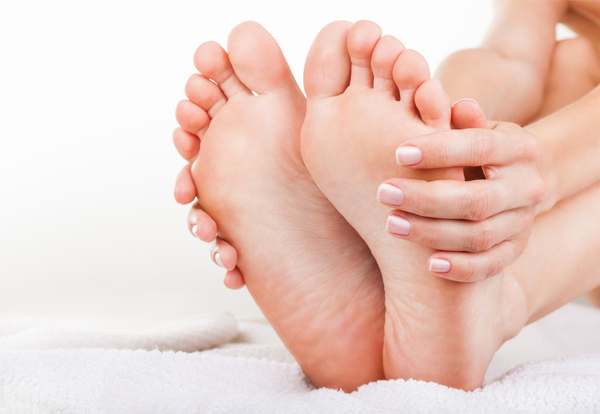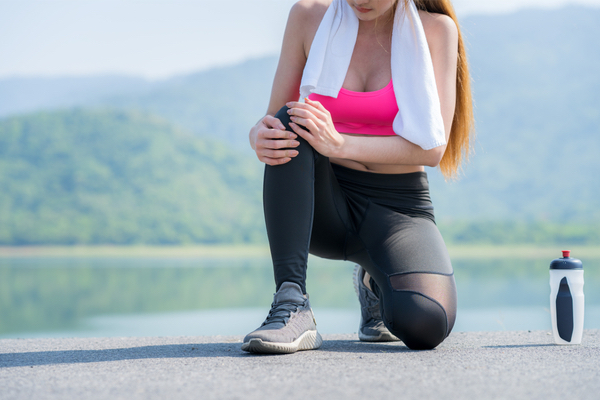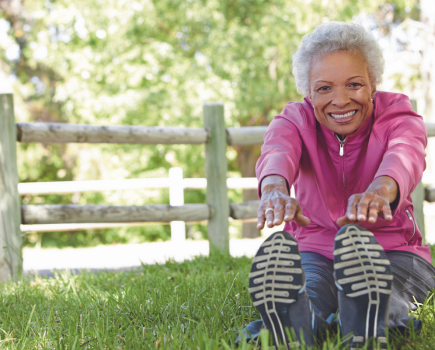Getting an injury can really stop your fitness routine in its tracks. Here’s how to avoid it… and some tips for making a quick recovery if you do hurt yourself.
If you’ve settled into a fitness routine, the last thing you need is having your plans scuppered by an injury. But there’s lots of action you can take to avoid one.
‘One of the best ways to prevent exercise-related injuries is to make sure you’re using proper form and technique.
This will ensure you’re recruiting all of the right muscle groups for the exercise so that no one part of your body is overcompensating,’ says David Wiener, training specialist at fitness app Freeletics (freeletics.com).
‘Rest days are another way to help prevent injury, giving your body time to recuperate after an intense training session and letting your muscles repair.’
Here we investigate how to prevent and treat some common complaints as well as looking at what exercise you can do when injured – but of course if you’re worried you should first visit your GP or a physiotherapist.
 FEET
FEET
Stay safe:
As many runners will know, pounding the pavement can lead to serious foot pain – in particular the dreaded plantar fasciitis, or heel pain, which is thought to affect 10 per cent of us at some point.
‘High impact exercises can create forces which are up to 20 times your weight, and just a couple of places you will feel these are your feet and your knees,’ says David. ‘Activities such as running, aerobics or tennis where you’re bouncing around on hard surfaces can cause foot pain.’
The main way to avoid developing plantar fasciitis is to have your gait analysed at a sports shop (many offer this for free) to help you buy suitable trainers. It’s also worth building up your mileage slowly – the couch to 5K app is a great resource to stop newbies from getting carried away.
Take action:
People are somewhat divided on treatments for plantar fasciitis – many swear by rolling the foot with a golf ball or a frozen water bottle. Some physios recommend heel raises as a way to stretch the fascia muscle and build calf strength too.
Try one-legged calf raises on a step, with your heels hanging over the end – around 30 each side per day.
In the meantime, soothe aching feet with a pair of Oofos Ooriginal flip-flops (oofos.co.uk), which use special technology to cradle your arches, and are seriously comfortable.
Strive Footwear also does arch-supporting shoes that help some people with plantar fasciitis, yet there’s no compromise on style. We love the Milan loafers in Anthracite (strivefootwear.com).
Keep moving:
‘If you suffer from a foot injury, swimming is a good option as its non-weight bearing and low impact,’ says David. ‘You can also modify many moves to make sure you’re evenly balancing your weight (speak to a physio or personal trainer) but if pain persists it’s advisable to stick to non-weight bearing activities such as cycling or rowing.’
 KNEES
KNEES
Stay safe:
Knee injuries are particularly common in people who do high intensity exercises. Loui Fazakerley, a personal trainer at Third Space London, recommends strengthening your glutes. ‘This will generally help to stabilise the knee joint and reduce the risk of injury. Try side lying clams,’ he says. Lie down on your side, feet and hips stacked, legs bent at 90 degrees and head supported by your lower arm. Keeping your abs engaged and feet together, raise your top knee as far as possible without rotating your hip. Hold for a second, squeezing your glutes, then lower and repeat 20 times on each side.
Take action:
Firstly, if you can afford it, get yourself to a physiotherapist. A US study found that physio can be as effective as surgery for knee injuries. In the meantime, pop on Boots Advanced Adjustable Knee Support (boots.com) which supports without restricting your movements.
Keep moving:
Keep things low-impact to avoid putting more strain on your knees. ‘Movement incorporating jumping is not recommended if you have knee problems. Walking can be a good option as it’s lower impact than running or jogging,’ says David.
 LOWER BACK
LOWER BACK
Stay safe:
Lower back injuries are often caused by a weak core. ‘If your core is weak, in a move like the sit up, your lower back will be doing the majority of the work, which could harm your back,’ says David. ‘Dynamic exercises such as burpees could also result in your lower back compensating for weaker muscle groups.’
But back injuries don’t always begin in the gym. ‘Spending long periods of time sitting down with bad posture can also be a major reason too. So have an awareness of your posture and try to improve your seating arrangements both at home and at work,’ says Loui.
Take action:
If you’re left feeling tender after a workout, try Deep Freeze Pain Relief Cold Spray (£4, deepfreeze.co.uk) to calm injuries.
It’s great for sprains, sore muscles and joint pain. ‘Gentle knee-to-chest stretches on the floor or
a yoga mat can also help to elongate the lower back, relieving tension,’ says David.
Keep moving:
Yoga and Pilates are great to help you relieve tension in a stiff back as well as strengthening your core to avoid repeat injuries. ‘Strengthen your core with floor-based exercises like front planks, side planks and glute bridges to help strengthen the muscles of the lumbo pelvic hip complex (the core) which are responsible for stabilising the spine,’ says Loui.







